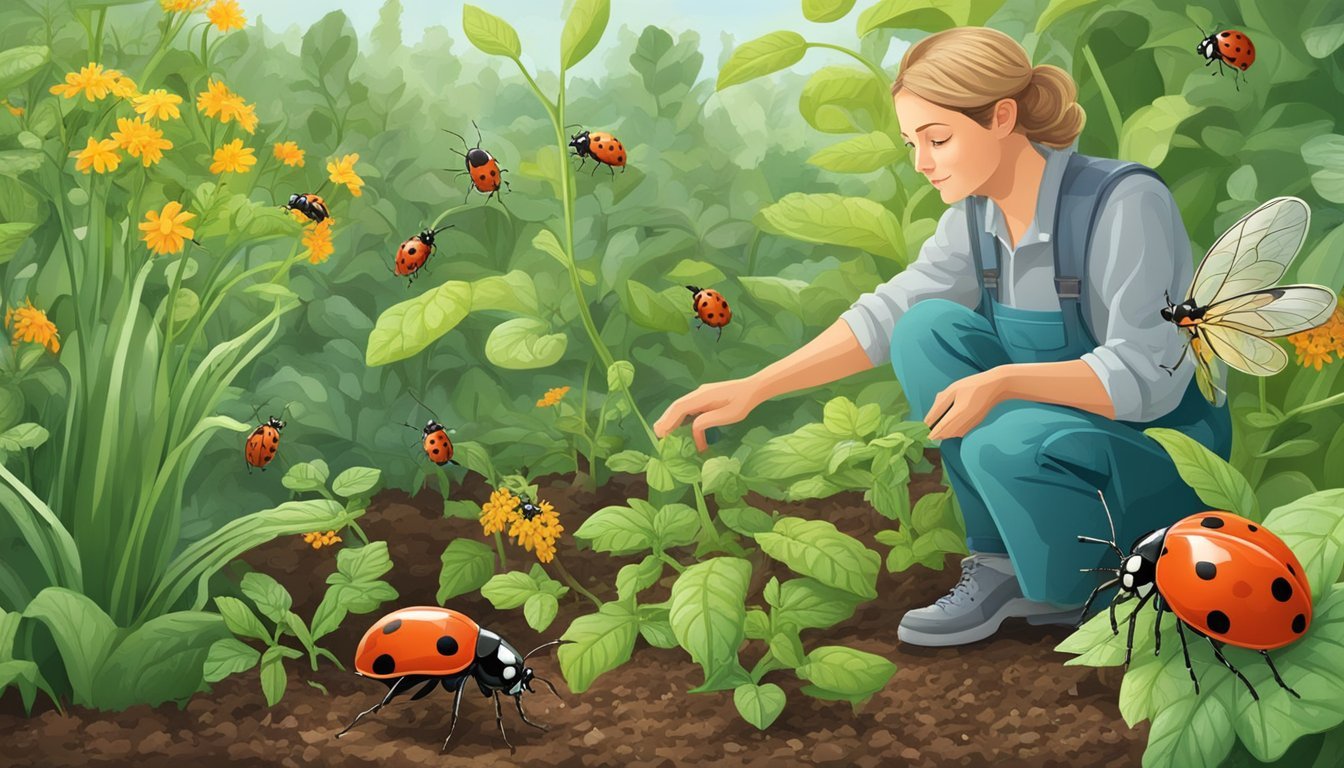Biological Pest Control
Integrating Natural Predators in Farm Management
Biological pest control is an environmentally sound approach to reducing harmful pests through the use of natural enemies. This method, also known as biocontrol, utilizes predators, parasitoids, and pathogens to keep pest populations in check. By harnessing the relationships and interdependencies found in nature, biological control strategies can effectively manage agricultural pests and invasive species without resorting to chemical pesticides. The process often involves a significant degree of active human management to ensure the effectiveness and ecological compatibility of the interventions.
The benefits of biological control are manifold. By integrating natural biological processes into pest management, there is minimal impact on the environment, which helps preserve biodiversity and ecosystem stability. The tactic specifically targets pest species while typically leaving non-target organisms unharmed. Biological pest control offers sustainability, as the self-perpetuating control agents can provide ongoing pest suppression. Farmers and land managers use these methods as part of an Integrated Pest Management (IPM) strategy to achieve long-term, environmentally conscious pest control.
However, implementing biological control is not without its challenges. It requires a thorough understanding of ecological interactions and careful planning to avoid unwanted consequences. The agents used must be well-suited to the habitat and climate, and their introduction should not disrupt existing ecological balances. Despite these complexities, biological control serves as a testament to human innovation in working synergistically with nature for pest management.
Principles of Biological Pest Control
Biological pest control leverages natural enemies of pests to manage agricultural and landscape pests effectively. It interconnects with integrated pest management strategies, aiming to reduce reliance on chemical pesticides.
Classical Biological Control
Classical biological control involves the importation of natural enemies to a region where they do not naturally occur. These biological control agents, such as parasitoids, predators, and pathogens, are introduced to control invasive or exotic pests. The release of these organisms is typically a one-time event, with the expectation that they will establish themselves and control the pest population over time. This method has been effective in managing pests such as the cottony-cushion scale with its natural predator, the vedalia beetle.
Augmentative Biological Control
Augmentative biological control consists of two main strategies: inundative release and seasonal inoculative release. Inundative release is the mass rearing and release of a biological control agent to provide immediate pest suppression, similar to a chemical pesticide application. Seasonal inoculative release involves releasing a moderate number of agents at critical times during the pest's life cycle, allowing the agent to reproduce and control the pest throughout the season.
Conservation Biological Control
Conservation biological control focuses on modifying the environment to protect and enhance the natural enemies already present. This could involve creating habitats that support pest predator populations or reducing practices that harm beneficial organisms. Emphasis is placed on maintaining a sustainable predator-prey balance within the ecosystem, ensuring long-term conservation of both the natural enemies and their effectiveness in pest control.
Biological Control Agents
Biological control agents are an integral part of managing pest populations. They include a variety of organisms such as parasitoids, predators, and pathogens, which can target and suppress specific pests naturally and effectively.
Parasitoids and Parasites
Parasitoids are organisms that lay their eggs on or in a host organism, leading to the eventual death of the host as the eggs develop. They are particularly effective for controlling pest populations. For instance, the Cotesia congregata is a parasitoid wasp known for using the tobacco hornworm as its host.
Parasites, in contrast, can live on or within a host organism and may cause harm but typically do not result in the host's death. An example includes various species of nematodes that parasitize soil pests.
Predatory Insects and Mites
Predatory insects, like the syrphus hoverfly larvae, consume large numbers of aphids, a common pest, during their development. This makes them valuable biological control agents.
Mites also play a role. Some mites predate on pest mites, helping to control populations that might otherwise damage crops.
Pathogens and Microbial Pesticides
Pathogens refer to bacteria, fungi, and viruses that cause disease in pest species, leading to their natural decline. Bacillus thuringiensis (Bt), a soil-dwelling bacterium, is among the most widely used microbial pesticides. Specific strains of Bt produce proteins that target certain pest insects, like beetles and moths.
Microbial pesticides can be more selective than chemical pesticides and often have minimal impact on non-target species, making them a safer alternative for pest control.
Implementation Strategies
The effective use of biological pest control involves strategic releases of beneficial organisms and meticulous integration into pest management systems. It is essential for practitioners to be judicious and methodical in employing these biological control measures.
Inoculative and Inundative Releases
Inoculative release is a tactic where a relatively small number of beneficial organisms are introduced with the expectation that they will establish a self-perpetuating population over time. These releases are particularly suited for long-term pest management and often require an initial period to become effective. Conversely, inundative releases involve releasing large quantities of natural enemies to quickly reduce pest populations. This augmentative biological control strategy acts more like a chemical pesticide with immediate effects but may need to be reapplied periodically.
Integrated Pest Management (IPM)
Integrated Pest Management (IPM) is a holistic approach that combines biological, cultural, physical, and chemical tools to minimize economic and environmental damages caused by pests. Biological control strategies are an integral part of IPM programs, ensuring that beneficial organisms support pest management practices. IPM seeks to maintain pest populations below damaging levels and uses routine monitoring to make informed management decisions.
Monitoring and Evaluation
A key component of a successful biological control program is rigorous monitoring and evaluation of pest populations and natural enemy efficacy. Practitioners must consistently assess the presence and impact of beneficial organisms to make timely management decisions. This data-driven approach ensures that the biological control measures are adapted to current conditions, maximizing the success of the pest management practice.
Benefits and Challenges
Implementing biological pest control techniques presents a unique set of benefits and challenges. While it promises a sustainable approach by leveraging beneficial organisms, it also confronts economic and regulatory hurdles.
Environmental Benefits
Biological Control is celebrated for its environmental sustainability. By employing beneficial organisms, it lessens dependency on chemical pesticides, thereby reducing the negative impacts on ecosystems. Predatory insects, parasitoids, and microbial agents target specific pests, which aims to preserve biodiversity and maintain ecological balance. Furthermore, it adapts to environmental conditions, often providing long-term pest management solutions.
Economic Aspects
The Economic Aspects of biological pest control highlight both its cost-effectiveness and the investment needed for research and development. While the initial investment in producing and distributing biological agents may be high, they often lead to savings by reducing pesticide use and preventing costly pest outbreaks. Over time, the resilience of these control methods can translate into significant economic benefits for farmers and the agriculture industry.
Regulatory and Safety Concerns
Regulatory bodies maintain strict oversight to ensure the safety and efficacy of biological pest control methods. They must assess the risk of introducing new organisms into an ecosystem, considering potential unintended consequences. Compliance with regulation is critical, as is the continual monitoring for any negative impacts. The regulatory framework is designed to protect both the environment and public health, while also enabling the adoption of safe biological control measures.
Case Studies and Historical Perspectives
This section examines several landmark events in the field of biological pest control that highlight the use of natural enemies and classical biological control methods to manage invasive species and agricultural pests.
Vedalia Beetle and the Cottony Cushion Scale
The Vedalia beetle (Rodolia cardinalis), a natural predator, was intentionally introduced to California in 1888 to combat the devastating cottony cushion scale (Icerya purchasi), which threatened the citrus industry. This case is one of the earliest and most successful instances of classical biological control, where imported vedalia beetles effectively eradicated the scale infestation within two years.
European Corn Borer and Trichogramma ostriniae
The European corn borer, a significant pest for corn crops, has been managed in part by the introduction of Trichogramma ostriniae, a parasitic wasp. Researchers and farmers employ these wasps today in a form of biological control where the wasp lays its eggs in the corn borer larvae, thus controlling the pest population without the use of harmful chemicals.
Alfalfa Weevil and Its Natural Control
The alfalfa weevil is another pest that has been targeted through biological control strategies. One approach has been the use of natural enemies like parasitoid wasps and entomopathogenic fungi to keep weevil populations at bay. These methods fall under the umbrella of natural control, which relies on the existing relationships in an ecosystem to regulate pest species.
Future of Biological Pest Control
Biological pest control is poised for significant transformations, with technological advancements leading to more sustainable agriculture practices. Key developments are expected in biotechnology, the scale of applications, and the integration with other control methods.
Advancements in Biotechnology
Biological pest control is becoming more precise with genetic engineering and biotechnological innovations. The introduction of targeted microbial pesticides and genetically modified organisms (GMOs) promises improved control of pest populations without harming non-target species. These cutting-edge solutions are designed to be environmentally sound and are vital for maintaining biodiversity in agro-ecosystems.
Expansion in Scope and Scale
The scope of biological control is expanding, encompassing a wider variety of crops and larger geographic areas. Efforts to scale up these practices are evident in the increase of commercial biological control agents. Farmers and agribusinesses increasingly acknowledge that sustainable agriculture is not only environmentally responsible but also economically viable, which encourages the further adoption and investment in biological control across diverse crop production systems.
Greater Integration with Other Control Methods
Biological pest control strategies are integrating more seamlessly with other pest management methods to create robust, multi-layered defense systems against pests. Combining biological weather stations that aid in early detection and identification of pests with biological agents enhances the overall effectiveness of pest management. The synthesis of these approaches ensures a long-term, sustainable solution for crop protection.
Frequently Asked Questions
Biological pest control offers a way to manage pests using their natural enemies. These questions delve into its benefits, processes, organisms involved, and impact on the environment.
What are the advantages of using biological methods for pest control?
Biological pest control methods are environmentally friendly and can provide a long-term solution by maintaining the natural balance of organisms. Often, they target specific pests, reducing the collateral damage to non-target species and minimizing the chemical load on the environment.
What are some examples of organisms used in biological pest control?
Organisms used in biological control include predators like lady beetles and lacewings, parasites such as certain wasps, and pathogens including fungi, viruses, and bacteria that are particularly virulent to pests.
How does classical biological control differ from other pest management strategies?
Classical biological control involves the introduction of a pest's natural enemies to a new locale where they do not naturally occur. The goal is to establish a self-sustaining population of the beneficial organisms to control pest populations over time.
What are the potential disadvantages or limitations of biological pest control?
Biological pest control can be limited by certain factors, such as the time it takes for predator populations to establish and control pest populations effectively, and the possibility of the control organisms becoming invasive themselves.
How is the effectiveness of biological pest control assessed?
The effectiveness of biological pest control is measured by monitoring pest populations and assessing their impact on crop yield and quality. Long-term studies may be conducted to determine the sustainability and ongoing effectiveness of the control methods.
What are the environmental impacts of implementing biological control methods?
The environmental impact of biological control methods is generally positive, as they help reduce the use of harmful chemicals, preserve biodiversity by maintaining natural predator-prey relationships, and can improve soil health and ecosystem stability.




